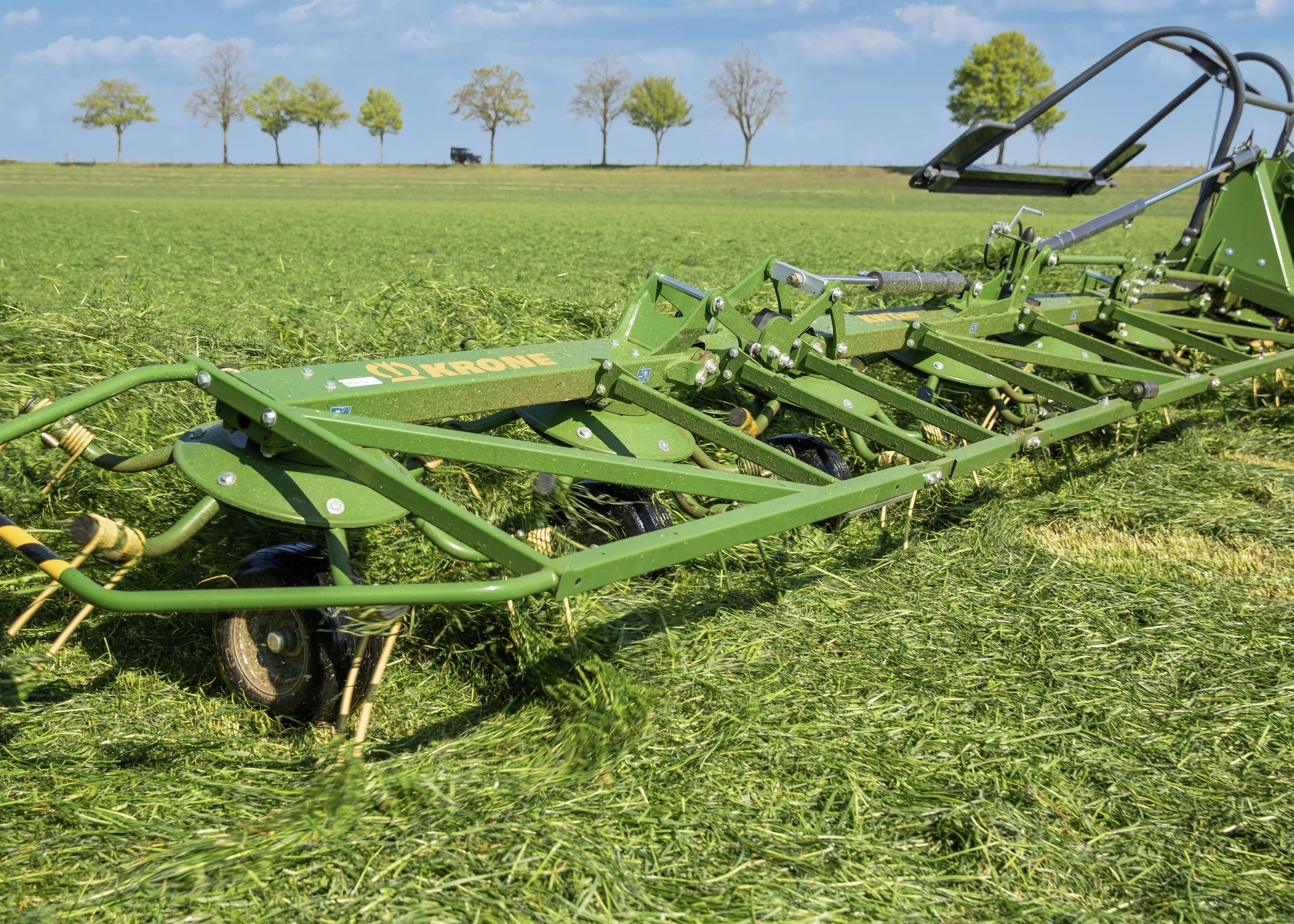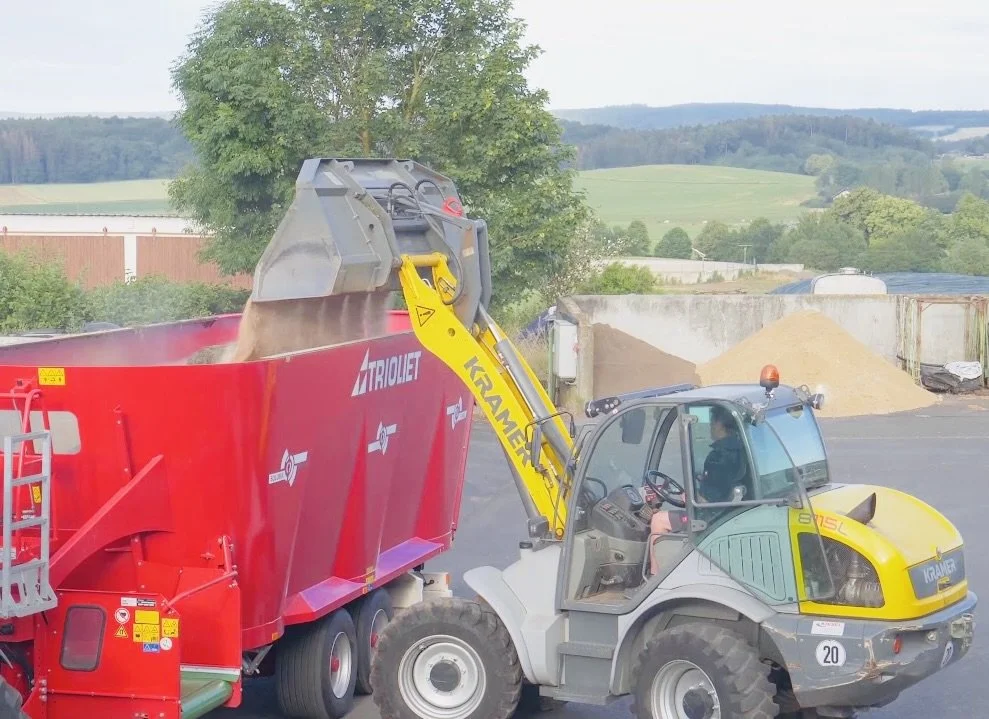Is it worth tedding out grass silage?
To ted or not to ted, that is the question. Most of us are well aware of the (theoretical) benefits of tedding out grass, but it’s a faff and it’s expensive, so many just don’t bother. In my experience there are silage producers in all three camps; the “tedders”, the “just row it ups”, and the “it depends”. Well in an attempt to upset as few as possible, I’m going to try and steer a middle course and explore why you might want to change your view on tedding grass for silage.
Krone KWT Tedder
For those of us lucky enough to be producing grass silage in the temperate climate that is the UK and Ireland, we have to plan to get the silage dry matter right. And getting the dry matter right is really important because it’s one of the keys to maximising the nutritional value of your grass. The target should be close to 30% dry matter (give or take a percent). Any lower and the bacteria will have to use more of the grass sugars to achieve a stable fermentation. Much higher and the resultant silage is vulnerable to aerobic instability once you start to use it.
Does it matter how long it take to wilt silage?
So you have a target of 30% dry matter for the silage but it’s likely the grass you’re mowing is somewhere between 15% and 22% dry matter. The “just row it ups” will champion the mower conditioner and the 24 hours wilt to get that grass dried to 30% dry matter. And they would be right, in most cases this will do the trick. Obviously it depends on the weather conditions, the grass maturity and species etc etc..
This is where the “it depends” crew come in. In a catchy year, when the sun is shy and the air damp a trip out with the tedder can help you get to that target dry matter a bit quicker than just leaving it in the row. So just what is the point of tedding grass when the weather is great and the grass in perfect condition? The answer is because it speeds up the wilt and that is something that’s often undervalued.
In great conditions it’s possible to mow grass at 15%-18% DM and pick it up at 30% DM just 5 hrs later if you use the tedder straight away. In theory then you - or your contractor - can mow 150 acres between 10am and 2pm then start picking up at 3pm and have it all in the clamp at 30% dry matter by 9pm. To do this you are going to have to ted that grass within an hour of mowing it and to cover that area you are going to need a big machine or two to avoid excessive forward speed.
Trailed Pottinger HIT Tedder
Now that sounds neat doesn’t it, the early cut grass got a 5hrs wilt in the best conditions and the later cut got an extra 40% wilting time so the target of 30% is easy to achieve. So what is not to like? Well I guess it costs more to ted the grass and what was the point because if you just left it in the swath its would be fit to pick up tomorrow morning?
Tedding costs so much - is it really worth it?
Tedding grass in the UK for 2023 costs around £8.50 per acre (or €24 per Ha) so in this example that’s around £1,275 to shake out this grass silage. At a typical yield of 5.5t DM/ha or fresh yield of around 7.5t per acre we should have 1100t in the clamp and the tedding has cost around £1.15 per tonne.
That’s what its cost but what has this saved and where is the benefit? Well the benefit should be in the extra energy that was saved in the grass. To understand this you need to remember that the grass is still living even though it’s been cut off and conditioned. The respiration of the plant cells continues to burn up the plant sugars until plant has run out of moisture and the leaf stomata close. So the longer it take to wilt the crop, the more sugar is lost in respiration. This sugar loss is a direct loss of ME in your cows’ diet.
Sugars will decline from cutting until ensiling; although some of the remaining sugar will then be used by the fermentation bacteria who use this energy to produce the acid that will preserve your forage. Predicting the in-field losses of sugar is difficult because there are just too many variables. As a general rule, the losses decline as the crop dries so the highest losses are just after cutting. So if it's difficult to predict the cost of the losses, let's turn this around and calculate how much sugar you would need to preserve to cover the tedding costs.
Cost cost of replacing lost energy
Firstly we need to assume there will be enough sugar to achieve a good fermentation because if not, we can lose just about half the silage value if the fermentation is poor. So we start with a good crop of high sugar grass. Currently I am working on a value / cost of that silage to be around £35-£36 per tonne of fresh weight and with an ME of 11.5MJ per kgDM. This makes a mega joule of energy in grass silage about 1.01p. Now if we need to replace lost energy with bought in barley at £160 per tonne, then a replacement mega joule is around 1.41p. Handily that’s exactly 0.4p per MJ more expensive.
Trioliet mixer wagon
Getting back to that wilting silage, leaving it overnight might cost you 0.3MJ per kg DM of ME (11.2ME from 11.5ME) compared with shaking out the silage and picking it up the same day as mowing. Running the numbers this will lose you a total of just over 100,200 mega joules of energy. To replace this with barley you will need almost 9t at a cost of around £1,440.
Now I’ve cheated to make those figures work out to be similar and to be honest I would expect the ME loss to be higher than those quoted above. In reality I would expect a silage that’s picked up the same day as its mown to be more than 12MJ/kgDM. Compared to that left for 24 hrs I would expect at least a 0.5-0.75 MJ/kgDM difference so the loss of energy would be more like £2,300 to £3,500.
Claas Volto tedder in action
So tedding might be a bit more attractive than you first thought, or maybe this has just confirmed what you already believed. A single pass with a tedder can well be money well spent. Going through a second time has little benefit unless the crop is very heavy. This might have answered one question but it raises many more, like how wide does the tedder need to be, how fast should it travel and how do you organise silage to be cut and picked up in one day - but those are questions for another article or two.
If you want to know more about tedding grass silage or would like to discuss any other aspects covered in this series, contact me at jeremy@silageconsultant.co.uk



